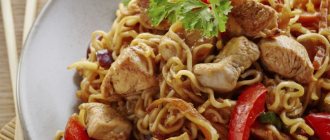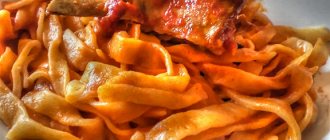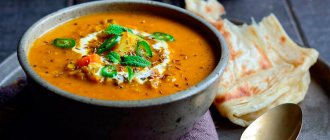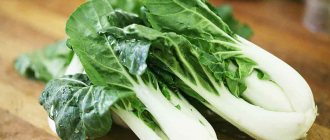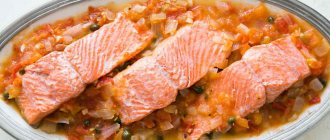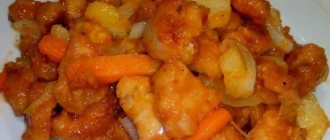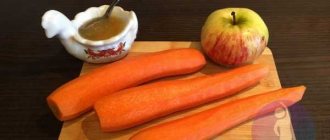Egg tofu cheese - 260 g, onion - 100 g, carrots - 130 g, bell pepper - 100 g, potato starch - 2 tbsp. l., vegetable oil - 2 tbsp. l., sesame seeds - 10 g. For the sauce: a glass of water, 1 tbsp. l. potato starch, 5 tbsp. l. soy sauce
Carefully remove the tofu packaging and cut into 2 cm thick circles. Roll each circle in starch and fry in hot oil until golden brown on both sides. Place on a paper towel to remove excess oil. Cut the onion into feathers, pepper into large pieces, carrots into thin slices. Place chopped vegetables in the pan where the tofu was fried, add sesame seeds and cook for 5 minutes over high heat, stirring constantly. To make the sauce, combine cold water with starch and soy sauce. Place fried tofu in a frying pan with vegetables and pour in the sauce. Stir gently and cook over medium heat until the sauce thickens, 2 minutes.
Cucumbers - 700 g, garlic - 3 cloves, corn starch - 2 tbsp. l., a pinch of ground chili, vegetable oil - 1 tbsp. l., salt - 2 tsp.
Peel the cucumbers, cut them in half lengthwise and remove the seeds with a teaspoon. Cut the cucumbers into pieces 1.5 cm wide. Sprinkle with salt, stir, put in a colander. In 20 minutes. Rinse the cucumbers with warm water and dry. Roll in starch. Peel and chop the garlic. Heat oil in a wok, fry garlic with ground chili, 30 seconds. Add cucumbers and fry, stirring, for 4 minutes. Serve immediately.
Beijing cabbage - 1 head, carrots - 2 pcs., sweet red pepper - 1 pc., sesame seeds (seeds) - 1 tbsp. l., hot green pepper - 1 pc., vegetable oil - 2 tbsp. l., ginger root - 2 cm, raisins - 1 tbsp. l., peeled shrimp - 200 g, sugar - 1 tsp, champignons - 200 g, soy sauce / sukiyaki sauce - 2 tbsp. l., sherry - 1 tbsp. l.
Cut the champignons into thin slices, carrots into strips, sweet peppers into strips, hot peppers into thin rings. Grate the ginger. Heat one third of the vegetable oil in a wok. Add hot pepper and ginger and fry for 3 minutes. Add shrimp and cook, stirring, for another 4 minutes. Transfer to a bowl. Add a little oil to the wok, add carrots and bell peppers. Fry vegetables, 6 minutes. Place in a bowl with shrimp. Pour the remaining oil into the wok, add the mushrooms, sprinkle with half the sherry and cook, stirring, for 7-8 minutes. Transfer to a bowl with vegetables. Separate the cabbage into leaves and chop into thin strips. Place the cabbage in the wok, drizzle with the remaining sherry, cook for 3-4 minutes. Add all the fried ingredients, pour in soy sauce and sprinkle with sugar. Add raisins and heat everything together for 2-3 minutes. Remove from heat and sprinkle with sesame seeds.
Eggplant - 2 kg, sweet pepper - 0.5 kg, onions (large) - 3 pcs., carrots (large) - 3 pcs., garlic (head) - 1 pc., parsley - 1 bunch, seasoning (for Korean carrots) - 1 pack, vegetable oil - 1 cup, sugar - 4 tbsp. l., salt - 1 tbsp. l., vinegar - 150 ml.
Wash the eggplants, cut off the stems. Boil them for 7-10 minutes. in salted water, let cool, squeeze, peel if desired. Cut the eggplants into large columns. Cut the pepper into strips, onion into rings, grate the carrots on a coarse grater. Finely chop the garlic and parsley. Mix all ingredients, add seasoning, vegetable oil, sugar, salt and vinegar. Keep for a day at room temperature. Keep refrigerated.
Chicken gizzards - 1 kg, onions - 2-3 pcs., carrots - 1-2 pcs., cucumber - 2-3 pcs., vegetable oil, soy sauce, vinegar - 2 tbsp. l., garlic - 2-3 teeth.
Wash and peel the chicken gizzards, add water and cook until soft (1-1.5 hours). Then cool and cut into medium-sized cubes. Cut the cucumbers into the same cubes, place in a bowl, pour in soy sauce and leave to marinate for at least 15 minutes. Finely chop the onion, grate the carrots on a coarse grater and sauté in butter until soft. Add cucumbers and gizzards to the onions and carrots. Mix everything. Pour vinegar and pepper to taste. Heat oil in a frying pan, add finely chopped garlic, stir and immediately pour into a bowl with the appetizer. Mix everything well, taste for salt and pepper. Let the salad brew (at least 1 hour, preferably until tomorrow). Serve chilled.
Chicken fillet - 200 g, soy sauce - 4 tbsp. l., white radish - 100 g, carrots - 100 g, petiole celery - 1 stalk, funchose - 50 g, vinegar (rice) - 1 tbsp. l., olive oil - 2 tbsp. l., Tabasco - 4 drops, green onions, cilantro, pickled ginger - 1 tbsp. l.
Cut the chicken fillet into thin strips. We also cut (grate) radish, celery and carrots into thin strips. Prepare the marinade: add rice vinegar, olive oil and Tabasco to soy sauce. Divide the marinade in half: pour the chicken in one part, and the vegetables in the other. Leave to marinate for 20 minutes. Meanwhile, cook the funchose (as a rule, it is enough to put it in boiling water for 3 minutes). We wash the finished funchose in a colander with cold water. Fry the marinated chicken fillet in a grill pan for 2 minutes. from each side. We put fried fillet and pickled vegetables along with the marinade into the funchose. Add ginger slices. Sprinkle green onion feathers and cilantro leaves on top. Serve immediately warm or chilled.
Green beans - 500 g, pork fillet - 250 g, garlic - 2 cloves, soy sauce - 1 tbsp. l., sesame oil - 0.5 tsp., vegetable oil - 2 tbsp. l., sesame seeds - 3 tsp.
Cut the pork fillet into thin strips. Dry. Heat 1 tbsp in a frying pan. l. oil, add meat, season with salt, sprinkle with sesame seeds and fry over low heat for 5-7 minutes. Pour in the remaining oil, add the beans and cook everything together for another 3-4 minutes. Finely chop the garlic, mix with soy sauce, sesame oil and add to the pan. Warm up for 1-2 minutes.
200 g of rice, a bunch of green onions, 1 bell pepper, fresh peas or a jar of corn, 3 teeth. garlic, 3 eggs, 2 tbsp. l. oil and soy sauce.
As a rule, cold, yesterday's rice is used for this dish. Gently knead all the lumps with your hands. Heat the oil in a saucepan (try not to let it boil). Add chopped green onions there; no need to fry them, just soften them in oil. Immediately after the onion, add the diced sweet pepper. In Chinese cuisine, it is important to remember that vegetables are not fried, but lightly stewed in oil. When all the vegetables have become soft, add fresh green peas or corn, then soy sauce, mix everything and remove from heat. Next step: take a clean frying pan, pour in a tablespoon of oil, add eggs and mix the mass with a wooden spatula. At the moment when the eggs begin to curl, you need to quickly add rice and vegetables and mix everything. Taste it. If there is not enough salt, you can add a little.
Potatoes - 2 pcs. large, pork (or chicken fillet) - 200 g, bell pepper (red) - 1/2 pcs., garlic - 2 cloves, soy sauce (Kikkoman) - 2 tbsp. l., sugar - 1 tbsp. l., red hot pepper - 1 pc., vinegar (rice) - 1 tbsp. l., green onions, vegetable oil - 2 tbsp. l.
Peel the potatoes and grate them into thin strips. Fry in hot oil until golden brown (about 5 minutes). If you are cooking a lot, then fry in batches. Remove the finished potatoes from the pan to a plate. Cut the meat (it is better to first freeze it and thaw it slightly) into thin strips. In the pan where the potatoes were fried, fry over high heat for about 10 minutes. Add bell pepper to the pork (cut into thin strips), green onions (cut into rings along with the white part) and finely chopped garlic. Mix. Add soy sauce, sugar and vinegar, mix and simmer for 1 minute. Add fried potatoes. Stir and turn off the heat. Serve the salad hot, sprinkled with green onions.
Eggplant - 1 kg, bell pepper - 2 pcs., onions - 2 pcs., potatoes - 4 pcs., salt - 1 tsp, sugar - 2 tsp, garlic - 5 teeth, water - 250 ml, soy sauce - 3-5 tbsp. l., starch - 1.5 tbsp. l., oregano - 2 pinch., Malasyan seasoning - 1 pinch., greens (cilantro, parsley).
There are many recipes for chisancha, this is one of the options. Cut the eggplants into cubes, add salt and set aside for half an hour. Cut onions and peppers into large pieces, potatoes into slices. Fry the potatoes in oil until golden brown, over high heat, do not add salt. Place the finished mixture into a dish. Fry the peppers and onions in the same oil, without adding salt. Transfer to a dish with potatoes. Now it’s time for the eggplants - we wash them of salt, squeeze them, dry them and fry them in the same frying pan, sprinkling them with sugar. When the eggplants are ready, add all the fried vegetables to the frying pan. (If, having deviated from the recipe, you want to add tomato slices to the dish, now is the time). Add chopped garlic, soy sauce, oregano, and Malasyan seasoning. Simmer for another minute, stirring. Mix the starch in the water, carefully add it to the vegetables, mix well, continuing to simmer over medium heat. After 30 seconds the starch will thicken. Sprinkle with herbs and serve.
Eggplant - 1 kg, carrots - 2 pcs., white cabbage - 500 g, vegetable oil - 100 g, garlic - 5 cloves, vinegar (9%) - 2 tbsp. l., ground coriander, salt, black and chili pepper, sugar.
Grate the carrots in Korean style, add salt, sprinkle with sugar and mash a little. Chop the cabbage, mash, add salt and also add a little sugar. Mix cabbage with carrots, add garlic, coriander, vinegar, chili and black pepper to taste. Mix everything thoroughly and let it brew for 2 hours. Peel the eggplants and cut into cubes. Add a lot of salt and let it sit for about an hour. Then we wash them, dry them with a napkin and fry them in portions until golden brown, about 5-7 minutes. When the eggplants have cooled, mix them with cabbage and carrots and season with oil. The salad is especially good on the second day.
700 g Chinese cabbage, 1 tbsp. l. sesame oil, 110 g sugar, 5 small dried chili peppers, 1 tbsp. l. finely chopped fresh ginger, 1.5 tbsp. l. salt, 2 tbsp. l. finely chopped garlic, 3 tbsp. l. peanut butter, rice or apple cider vinegar - 150 ml.
Cut the Chinese cabbage into strips or squares, blanch in hot water for 2 minutes, drain in a colander and dry. Heat peanut and sesame oil in a frying pan, add chili there. When the peppers turn black, remove the pan from the heat and pour boiling oil over the cabbage. Add sugar and vinegar, stir. Then add salt, ginger and garlic, mix thoroughly again. Let the snack stand at room temperature for several hours, and then overnight in the refrigerator.
Age category of materials: 18+
- Amurskaya Pravda from 09/12/2019
Hunan cuisine (Xiang cuisine)
Hunan cuisine, also often called Xiang cuisine, comes from a province that has been called "the land of fish and rice" for centuries.
When it comes to food and food products, Hunan Province has never lacked it. The main features of Hunan cuisine are the rich flavors of the dishes and the delicate use of hot red pepper. Hunan cuisine is also very flavorful. Many of her dishes feature fresh vegetables that retain their crunchy texture by being slightly undercooked or undercooked. Hunan cuisine is said to have the saltiness of northern Chinese cuisine, as well as the sweetness of southern Chinese cuisine. A large proportion of the ingredients used in Hunan cuisine are various vegetables. Perhaps this is one of the reasons that Hunan cuisine is considered one of the most inexpensive.
Hunan cuisine uses cooking methods such as stewing in oil over low heat, stir-frying over high heat, steaming and smoking. Hunan cuisine (Xiang cuisine) is famous for its stews. At the same time, chefs from Hunan Province are also good at cooking methods such as simmering and baking, which bring out the best qualities of local products. Equally important to Hunan cuisine (Xiang cuisine) is the way different types of meat and vegetables are cut. Skillfully cut products are pleasing to the eye, and as for meat, its taste properties, for example, such as tenderness and juiciness, depend on how it is cut.
Special seasonings in Hunan cuisine include soy sauce, tea seed oil, hot pepper oil, Chinese red pepper, fennel, Chinese cinnamon bark and many others. Many dishes of Hunan cuisine (Xiang cuisine) have a fiery taste, as various seasonings, including hot red pepper, occupy a special place in it. Some people say that some Hunan dishes (Xiang cuisine) remind them of South American or Indian dishes. Residents of Hunan Province seem to be ready to put hot red peppers in any dish or product, with the possible exception of ice cream.
Anhui cuisine (Hui cuisine)
Anhui cuisine is also called Hui cuisine or Wan cuisine. It is one of the eight major cuisines of China. As you can guess from the name, this cuisine comes from Anhui Province, which is located in northern China. Anhui cuisine (Hui cuisine) consists mainly of three styles, each representing a specific region:
the Yangtze River region, the Huai River region and the southern region of Anhui Province. The most notable of these traditions is that of the southern regions of Anhui Province. The birthplace of the style of the southern regions of Anhui Province is considered to be She County, which is located in the area of the world famous tourist destination - the Yellow Mountains region.
Anhui Province has an abundance of uncultivated land, mountains and forests. These resources supply Anhui cuisine (Hui cuisine) with a variety of local ingredients.
Anhui cuisine (Hui cuisine) uses only local products, so the freshness of the dishes is an essential quality.
Most of the ingredients of Anhui cuisine (Hui cuisine), such as pangolin, stone frog, mushrooms, berries, tea leaves, bamboo shoots and dates, are obtained from the mountainous areas of the province.
In the Huangshan Mountain area, you can find many different plants and living organisms that are eaten. There are especially many wild herbs here. Anhui cuisine (Hui cuisine) places great emphasis on natural products, making it a healthy cuisine.
Anhui cuisine (Hui cuisine) uses traditional cooking methods. Some of the dishes in this cuisine are used for medicinal purposes.
The use of wild herbs in Anhui cuisine (Hui cuisine) has a number of interesting features.
Anhui cuisine (Hui cuisine) pays great attention to cooking time and temperature.
High, medium or low heat can be used depending on the quality and characteristics of different products and the taste requirements of the finished dishes. Anhui cuisine (Hui cuisine) requires special skill in various types of stewing. It is in stewing that one can achieve the lightness of taste that is characteristic of Anhui cuisine.
Some typical dishes that are prepared using the brown gravy method may seem too greasy compared to dishes prepared using other methods. Ham is often added to dishes to enhance the taste.
Some of the typical dishes of Anhui cuisine (Hui cuisine) are frog cooked over high heat with mushrooms, fish and shrimp steak, Li Hongzhang meat and vegetable stew, Bagong bean curd, fish with grapes, mountain sprouts bamboo, cold cuts, shrimp in a swallow's nest and red tato in honey.
Tangerine slices in caramel
Ingredients: tangerines, granulated sugar.
Preparation
Place the sugar in a heavy-bottomed saucepan and add water until it completely covers the sugar. Bring to a boil and simmer for 8-10 minutes until the sugar begins to caramelize. Then lower the heat and continue cooking for 5-6 minutes until the caramel turns brown. Dip each tangerine slice into caramel, then into ice water, and place on a glass plate to harden.
Photo: Natalia Mologina
